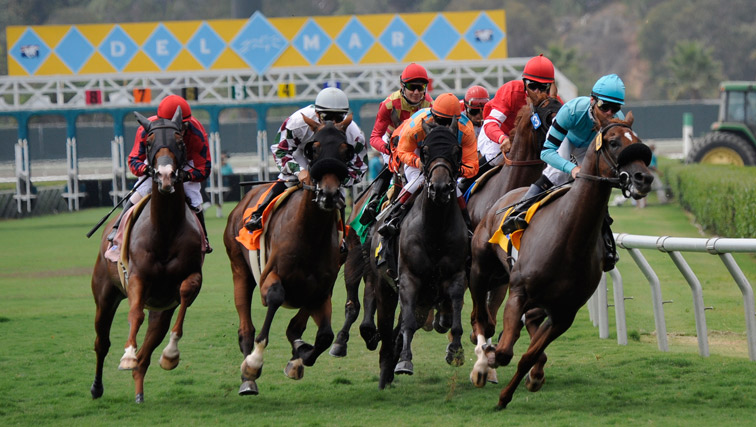Tip of the Week: What’s the Hurry?

Racing at Del Mar. (Photo by Eclipse Sportswire)
It’s usually pretty simple to pick out a closer who endures a bad trip.
There’s often a highly discernible moment, such as when a jockey pulls hard on the reins or the horse abruptly loses momentum when he lacks running room.
Picking out a front-runner who has a tough trip is an entirely different task.
You can sometimes rely on pace figures to find out if a horse ran unusually fast. Yet sometimes simply watching a race unfold and checking an Equibase chart can point out a strong effort on the front end.
A good example was the ninth race at Del Mar on July 19. It was a $16,000 claimer at 6 ½ furlongs for horses who had never won two races.
As soon as the starting gates opened, there was a lively four-way duel for the lead through the opening half-mile. The embattled leaders covered those four furlongs in a quick :45.68, yet what stood out more was the odds of those horses.
In this case, it wasn’t a favorite battling with three overmatched longshots.
Looking at the chart of the race, there was a 21-1 shot in the mix, but the other three horses were the second, third and fourth choices in the wagering: Public Policy (7-2), With the Breeze (4-1) and Ultimate Luck (5-1).
As the foursome moved along at a lively clip and opened a 4 ½-length lead on the horse in fifth, it was Public Policy who won the duel and kicked clear to open a 1 1/2-length lead at the eighth pole.
Unfortunately, the rigors of the pace battle caught up with Public Policy in that final furlong as Secret Command, the 2-1 favorite, closed from eighth to win by a length and a half.
Public Policy settled for second, but was well-clear of the rest of the field, winding up 3 ½ lengths ahead of the third-place finisher.
While the way Public Policy weakened at the end may have been disappointing to some of his backers, it was in fact a solid effort. After battling two of his main rivals from the start, his ability to sprint away from Ultimate Luck (who finished fourth) and With the Breeze (seventh) underscored how well he raced and that he might be quite dangerous in his next race.
That next race came on Aug. 15 at Del Mar when Public Policy returned in the same kind of $16,000 claimer at the identical 6 1/2-furlong distance and looked like a solid play based on his last effort. He was the 5-2 morning-line favorite, and wound up going off as the 2-1 favorite in the wagering.
The Aug. 15 race played out differently than Public Policy’s previous start as Dr. Vincentstein shot out to a four-length lead after the opening quarter mile. Yet the determination Public Policy displayed in the July 19 race once again came to the fore as he moved up along the inside from second and drew clear in the stretch to win by a length and a half, paying $6.40 for each $2 win bet.
THE LESSON: A speed duel can sometimes be judged by more than the fractions. If several of the favorites in a race are involved with the early pace and one of them wins that duel, it can be viewed as a solid effort even if that horse does not win the race.
